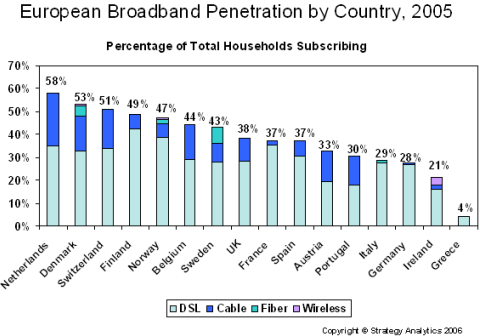Nordics and Netherlands Lead, While Germany and Italy Lag
Milton Keynes, UK, July 24, 2006 -- Broadband Internet access is quickly becoming a mainstream consumer service in Western Europe, but conditions for growth vary widely, with some of the continent's largest countries still trailing on broadband availability and adoption. That is the conclusion of a new report, "Broadband in Western Europe: Competition and Convergence Drive the Next Wave of Subscriber Growth," from technology research firm, Strategy Analytics, which finds that Nordic countries such as Finland, Sweden and Norway lead the region in broadband adoption, thanks to their strong competitive environments. In contrast, broadband penetration remains lower than average in Germany and Italy, where incumbent telecom operators dominate the market. A summary of 2005 broadband penetration rates by country is shown below.

"Countries with higher broadband penetration usually have significant facilities-based competition between telecom companies offering DSL and other providers, such as cable TV operators," notes Martin Olausson, Senior Analyst with the Strategy Analytics Broadband Media & Communications service. "In other countries, Local Loop Unbundling regulations have encouraged competition between incumbents and independent DSL providers, prompting both to offer faster broadband speeds and enabling new services such as Voice-Over-IP (VOIP) telephony and IP-based TV."
The report, which includes five-year forecasts for adoption of DSL, cable modem and other broadband technologies in 16 European countries, predicts that another 16 million households will adopt broadband this year, bringing the total base of subscribers in the region to 73.2 million. By 2010, Strategy Analytics forecasts that the number of broadband customers in Western Europe will reach 108 million, or 63 percent of all households.
"Ultimately we expect that the Internet and broadband services will be integrated into nearly all aspects of home life and social activity," says Olausson.